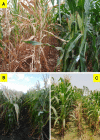Beat the stress: breeding for climate resilience in maize for the tropical rainfed environments
- PMID: 33594449
- PMCID: PMC7885763
- DOI: 10.1007/s00122-021-03773-7
Beat the stress: breeding for climate resilience in maize for the tropical rainfed environments
Abstract
Intensive public sector breeding efforts and public-private partnerships have led to the increase in genetic gains, and deployment of elite climate-resilient maize cultivars for the stress-prone environments in the tropics. Maize (Zea mays L.) plays a critical role in ensuring food and nutritional security, and livelihoods of millions of resource-constrained smallholders. However, maize yields in the tropical rainfed environments are now increasingly vulnerable to various climate-induced stresses, especially drought, heat, waterlogging, salinity, cold, diseases, and insect pests, which often come in combinations to severely impact maize crops. The International Maize and Wheat Improvement Center (CIMMYT), in partnership with several public and private sector institutions, has been intensively engaged over the last four decades in breeding elite tropical maize germplasm with tolerance to key abiotic and biotic stresses, using an extensive managed stress screening network and on-farm testing system. This has led to the successful development and deployment of an array of elite stress-tolerant maize cultivars across sub-Saharan Africa, Asia, and Latin America. Further increasing genetic gains in the tropical maize breeding programs demands judicious integration of doubled haploidy, high-throughput and precise phenotyping, genomics-assisted breeding, breeding data management, and more effective decision support tools. Multi-institutional efforts, especially public-private alliances, are key to ensure that the improved maize varieties effectively reach the climate-vulnerable farming communities in the tropics, including accelerated replacement of old/obsolete varieties.
Conflict of interest statement
The authors declare that they have no conflict of interest.
Figures




Similar articles
-
Approaches and progress in breeding drought-tolerant maize hybrids for tropical lowlands in west and central Africa.Plant Genome. 2024 Jun;17(2):e20437. doi: 10.1002/tpg2.20437. Epub 2024 Feb 20. Plant Genome. 2024. PMID: 38379199 Review.
-
Developing and deploying climate-resilient maize varieties in the developing world.Curr Opin Plant Biol. 2018 Oct;45(Pt B):226-230. doi: 10.1016/j.pbi.2018.05.004. Epub 2018 May 17. Curr Opin Plant Biol. 2018. PMID: 29779966 Free PMC article. Review.
-
Genomic-based-breeding tools for tropical maize improvement.Genetica. 2017 Dec;145(6):525-539. doi: 10.1007/s10709-017-9981-y. Epub 2017 Sep 5. Genetica. 2017. PMID: 28875394 Review.
-
Drought stress in maize: stress perception to molecular response and strategies for its improvement.Funct Integr Genomics. 2023 Sep 11;23(4):296. doi: 10.1007/s10142-023-01226-6. Funct Integr Genomics. 2023. PMID: 37697159 Review.
-
QTLian breeding for climate resilience in cereals: progress and prospects.Funct Integr Genomics. 2019 Sep;19(5):685-701. doi: 10.1007/s10142-019-00684-1. Epub 2019 May 16. Funct Integr Genomics. 2019. PMID: 31093800 Review.
Cited by
-
Genomic prediction of the performance of tropical doubled haploid maize lines under artificial Striga hermonthica (Del.) Benth. infestation.G3 (Bethesda). 2024 Oct 7;14(10):jkae186. doi: 10.1093/g3journal/jkae186. G3 (Bethesda). 2024. PMID: 39129203 Free PMC article.
-
Tackling G × E × M interactions to close on-farm yield-gaps: creating novel pathways for crop improvement by predicting contributions of genetics and management to crop productivity.Theor Appl Genet. 2021 Jun;134(6):1625-1644. doi: 10.1007/s00122-021-03812-3. Epub 2021 Mar 18. Theor Appl Genet. 2021. PMID: 33738512 Free PMC article. Review.
-
Genetic trends for yield and key agronomic traits in pre-commercial and commercial maize varieties between 2008 and 2020 in Uganda.Front Plant Sci. 2023 Mar 10;14:1020667. doi: 10.3389/fpls.2023.1020667. eCollection 2023. Front Plant Sci. 2023. PMID: 36968404 Free PMC article.
-
Does the adoption of soil carbon enhancing practices translate to increased farm yields? A case of maize yield from Western Kenya.Heliyon. 2022 May 21;8(5):e09500. doi: 10.1016/j.heliyon.2022.e09500. eCollection 2022 May. Heliyon. 2022. PMID: 35663740 Free PMC article.
-
Precision Soil Moisture Monitoring Through Drone-Based Hyperspectral Imaging and PCA-Driven Machine Learning.Sensors (Basel). 2025 Jan 28;25(3):782. doi: 10.3390/s25030782. Sensors (Basel). 2025. PMID: 39943421 Free PMC article.
References
-
- Abdullah Z, Khan MA, Flowers TJ. Causes of sterility in seed set of rice under salinity stress. J Agron Crop Sci. 2001;187:25–32. doi: 10.1046/j.1439-037X.2001.00500.x. - DOI
-
- Alam MA, Seetharam K, Zaidi PH, Dinesh A, Vinayan MT, Nath UK. Dissecting heat stress tolerance in tropical maize (Zea mays L.) Field Crop Res. 2017;204:110–119. doi: 10.1016/j.fcr.2017.01.006. - DOI
Publication types
MeSH terms
Grants and funding
LinkOut - more resources
Full Text Sources
Other Literature Sources
Medical

